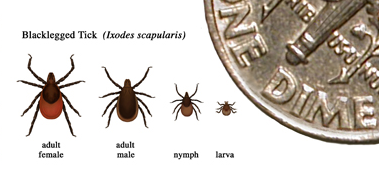Lyme Disease
For more tips on ticks, visit our Tick page. Click here for more information to Fight the Bite from ticks and mosquitoes.
Lyme disease is an illness caused by the bacterium Borrelia burgdorferi. Lyme disease is the most common tick-borne disease in Maryland. Other tick-borne diseases, such as Anaplasmosis, Babesiosis, and Ehrlichiosis also occur in this area. Learn more about other tick-borne diseases.
Lyme disease is spread by black-legged ticks, also called deer ticks. Deer ticks are very small.
Not all deer ticks spread Lyme disease, only those that carry the bacteria.
You can prevent Lyme disease by preventing tick bites. See our Ticks page for tips.
Symptoms
Early Lyme disease symptoms may include:
- Round red rash around the tick bite, like a bull’s eye with a clear center and a ring around it. Not everyone with Lyme will get this rash.
- Flu-like symptoms – fatigue, headache, fever, and achy muscles and joints.
- Usually occur within the first month after a bite.
Later symptoms may include:
- Arthritis
- Nervous system problems
- Heart problems
- Can occur several weeks or months after the bite.
Diagnosis
Lyme disease may be hard to diagnose because the symptoms are similar to many other disorders. Blood tests can help with the diagnosis. Health care providers also consider other factors, such as symptoms, history of tick bites, and possible contact with ticks.
Treatment
If there is a chance you have Lyme disease or any other tick-borne disease, see your health care provider as soon as possible. Early treatment may help prevent more serious illness.
Post-treatment Lyme Disease Syndrome
Some people have pain, fatigue, and achy muscles and joints even after treatment for Lyme Disease. A small number of people have these symptoms for over 6 months. This is called Post-treatment Lyme Disease Syndrome (PTLDS), though it is sometimes called chronic Lyme disease.
The cause of PTLDS is not yet known. It may be due to damage to tissues and the immune system from the Lyme Disease infection. Studies have not shown that people with PTLDS benefit from long-term antibiotics.
If you think you have PTLDS, work with your health care provider. Make sure you do not have another health issue that is causing your symptoms. Track your symptoms and ask about ways to treat them. Take care of yourself with a healthy diet and enough rest. Remember that people with PTLDS almost always get better, but it can take months.
Learn more from reliable websites, like the CDC and other government health agencies (.gov websites); information on the internet can be inaccurate.
Post-treatment Lyme Disease Syndrome (CDC)
For more information about Lyme disease, visit the following links:
Centers for Disease Control and Prevention (CDC) Lyme pages:
Lyme Disease: What You Need to Know

